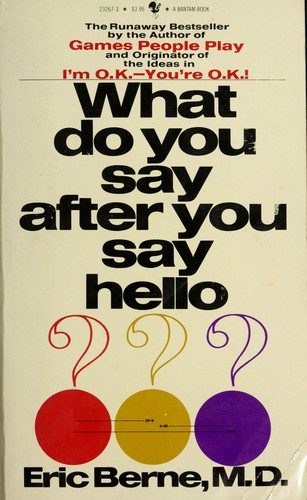
What do you say after do say hello by Eric Berne | Free PDF Download
Please share this book
The download button will start your download and show a message from our advertisers in a new window.
What Do You Say After You Say Hello?: An Honest Review
Have you ever wondered why you keep repeating the same patterns in your relationships and life? Why certain situations feel familiar, almost as if you’re following a pre-written script? Eric Berne, the renowned psychiatrist and founder of Transactional Analysis, explored this very question in his final book, “What Do You Say After You Say Hello?”. As a follow-up to his groundbreaking work, “Games People Play,” this book delves into the complex concept of “life scripts”—unconscious plans that we create in childhood that dictate the course of our lives.
I’ve had a chance to read this book, and I want to share my honest thoughts. Is this a deep dive into self-discovery, or is it too academic for the average reader? Let’s take a closer look at what makes this book a classic in the field of psychology.
Understanding the Core Concept of “Scripts”
According to Berne, a “script” is a life plan formed in childhood under parental influence. It’s not about conscious choices but about the unconscious forces that guide our behavior, emotions, and decisions. These scripts can lead to repeating patterns, from the jobs we choose to the partners we select and the problems we face. The book’s title refers to what happens after the simple social exchanges (“hello”), exploring the underlying, unspoken motivations behind our interactions.
A Deep Dive into the Book’s Key Ideas
This book is a fantastic resource for anyone who wants to improve their life. It’s a complete package that provides a structured path to learning the language.
The Three Ego States: Parent, Adult, Child
The book is organized logically, with each unit focusing on a specific grammar topic. It starts with a review of key concepts and then moves on to more complex topics. Each section is filled with activities that help students understand the concepts and apply them in a hands-on way.
The Psychology of Human Interaction
What sets this book apart is its focus on practical, hands-on activities. It doesn’t just give you a list of words; it provides clear, step-by-step instructions that show you how to use them in a real-life situation. This visual approach is especially helpful for learning nouns and verbs, as you can see them in action.
Who is This Book For?
This book is an excellent resource for a wide range of individuals.
Psychology Students and Therapists
This book is perfect for students in the fourth grade or at a similar level. It’s a great way to introduce them to the world of phonics and help them build a solid foundation.
Anyone Interested in Self-Awareness
For teachers, this book provides a complete and well-structured curriculum. For parents, it’s a great way to give your child an extra challenge or to help them with their homework.
Pros and Cons of the Book
Pros:
Comprehensive: It covers a huge range of topics and words.
Practical: The vocabulary is useful for real-life situations.
Structured: The thematic organization is great for memorization.
Cons:
Not a Standalone Resource: This book is for vocabulary, not for learning grammar or conversation skills from scratch.
Can Be Repetitive: For some students, the repetitive nature of the exercises might feel a bit monotonous.
How to Use This Book Effectively
Work Through the Sections: The book is designed to be used unit by unit. Follow the chapters in order to get the most benefit.
Create Your Own Sentences: After you learn a new set of words, try to write your own sentences or short paragraphs using the new vocabulary to make it stick.
Combine with Other Resources: Use this book for vocabulary, but combine it with other resources to practice your listening and speaking skills.

After Post template 2
After Post template 1
After Post template 2

